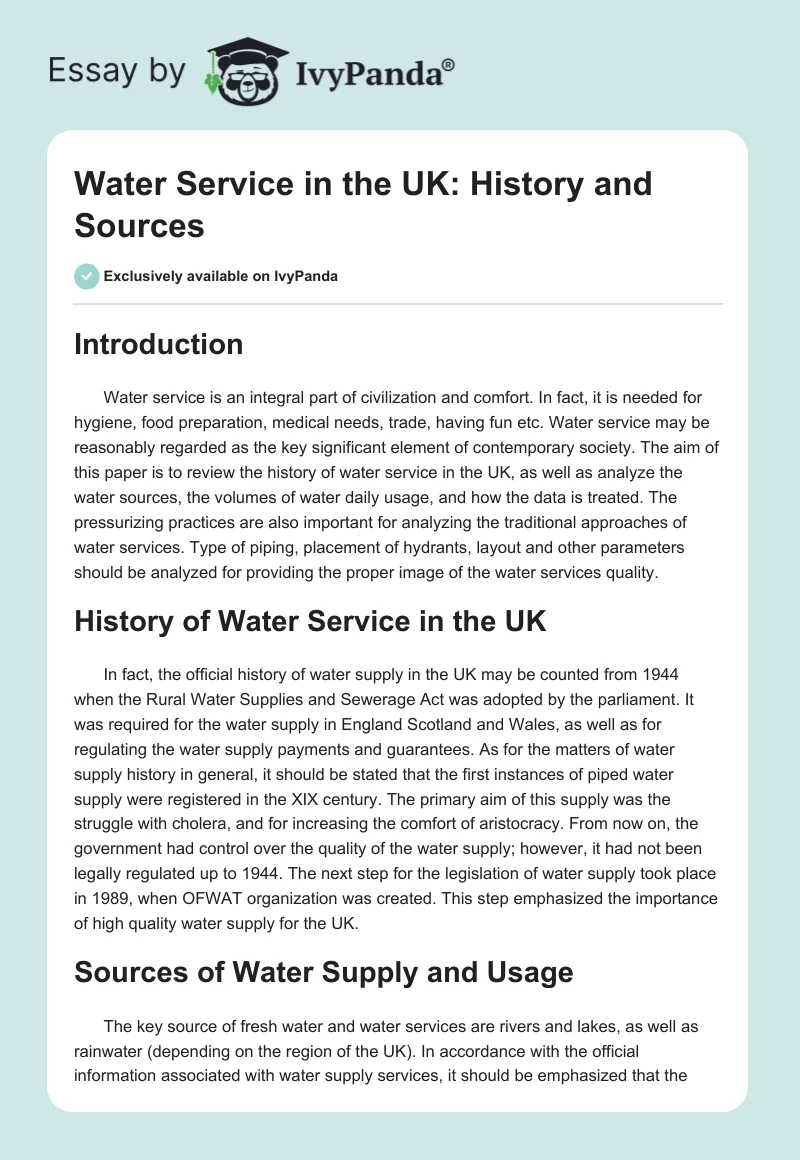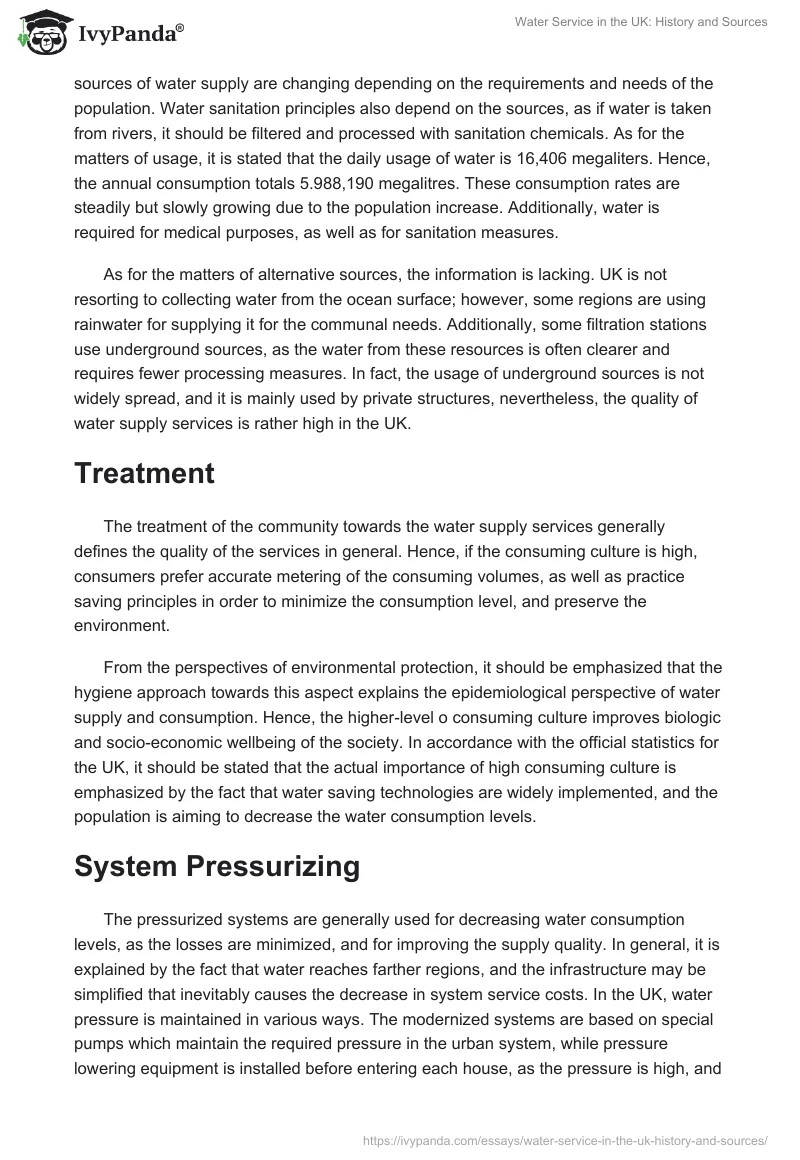Introduction
Water service is an integral part of civilization and comfort. In fact, it is needed for hygiene, food preparation, medical needs, trade, having fun etc. Water service may be reasonably regarded as the key significant element of contemporary society. The aim of this paper is to review the history of water service in the UK, as well as analyze the water sources, the volumes of water daily usage, and how the data is treated. The pressurizing practices are also important for analyzing the traditional approaches of water services. Type of piping, placement of hydrants, layout and other parameters should be analyzed for providing the proper image of the water services quality.
History of Water Service in the UK
In fact, the official history of water supply in the UK may be counted from 1944 when the Rural Water Supplies and Sewerage Act was adopted by the parliament. It was required for the water supply in England Scotland and Wales, as well as for regulating the water supply payments and guarantees. As for the matters of water supply history in general, it should be stated that the first instances of piped water supply were registered in the XIX century. The primary aim of this supply was the struggle with cholera, and for increasing the comfort of aristocracy.
From now on, the government had control over the quality of the water supply; however, it had not been legally regulated up to 1944. The next step for the legislation of water supply took place in 1989, when OFWAT organization was created. This step emphasized the importance of high quality water supply for the UK.
Sources of Water Supply and Usage
The key source of fresh water and water services are rivers and lakes, as well as rainwater (depending on the region of the UK). In accordance with the official information associated with water supply services, it should be emphasized that the sources of water supply are changing depending on the requirements and needs of the population. Water sanitation principles also depend on the sources, as if water is taken from rivers, it should be filtered and processed with sanitation chemicals.
As for the matters of usage, it is stated that the daily usage of water is 16,406 megaliters. Hence, the annual consumption totals 5.988,190 megalitres. These consumption rates are steadily but slowly growing due to the population increase. Additionally, water is required for medical purposes, as well as for sanitation measures.
As for the matters of alternative sources, the information is lacking. UK is not resorting to collecting water from the ocean surface; however, some regions are using rainwater for supplying it for the communal needs. Additionally, some filtration stations use underground sources, as the water from these resources is often clearer and requires fewer processing measures. In fact, the usage of underground sources is not widely spread, and it is mainly used by private structures, nevertheless, the quality of water supply services is rather high in the UK.
Treatment
The treatment of the community towards the water supply services generally defines the quality of the services in general. Hence, if the consuming culture is high, consumers prefer accurate metering of the consuming volumes, as well as practice saving principles in order to minimize the consumption level, and preserve the environment.
From the perspectives of environmental protection, it should be emphasized that the hygiene approach towards this aspect explains the epidemiological perspective of water supply and consumption. Hence, the higher-level o consuming culture improves biologic and socio-economic wellbeing of the society. In accordance with the official statistics for the UK, it should be stated that the actual importance of high consuming culture is emphasized by the fact that water saving technologies are widely implemented, and the population is aiming to decrease the water consumption levels.
System Pressurizing
The pressurized systems are generally used for decreasing water consumption levels, as the losses are minimized, and for improving the supply quality. In general, it is explained by the fact that water reaches farther regions, and the infrastructure may be simplified that inevitably causes the decrease in system service costs. In the UK, water pressure is maintained in various ways. The modernized systems are based on special pumps which maintain the required pressure in the urban system, while pressure lowering equipment is installed before entering each house, as the pressure is high, and may cause essential damages. Additionally, a pressurizing tank may be used. It stores the required amount of water which is supplied to a particular region.
In regions where the pumping system is not improved, the water is pumped into special tanks that are located above the ground, and the gravity is used instead of pumps that supply water to houses. In fact, some municipalities prefer the combined system, which allows to decrease supply system service costs, as well as maintain the supply services on a high level.
Type of Piping
The piping that is used defines the quality of the water supply system. In fact, the UK organizations are aiming to change the systems and use ecologically safe materials, as the existing infrastructure needs modernization and improvement. Metal pipes are subjected to liming and rusting, while plastic, if of low quality, may cause soil contamination and even cause harm to health of water consumers. Hence, OFWAT is aimed at controlling the quality of the pipes used for the piping system. In fact, the generally accepted pressure for the UK system is 4-5 bar for the urban regions. Nevertheless, the drawbacks and damages of the piping system, some people may get over 8 bar, while the others below 1 bar.
Type of Hydrants
The type of hydrants that are used for firefighting and included into the urban piping system depends on the location and concentration of the population in the region. Another parameter is the closeness of the easily flamed materials, hence, the classification of hydrants may range from 0 to 5000 gallons per minute. The pressure that is maintained in operating hydrants is close to 350 kPa. UK is mainly using “dry barrel” system of hydrants in order to prevent freezing, however, the pressure and capacity depend on the region.
Additionally, it should be stated that the actual position and usage of hydrants is closely linked with the availability of water sources. Some of them are not linked with the common water supply system and are included into a separate fire fighting system. However, if no hydrants are available, the water is totally secured from firefighting, and the emergency teams will have to use other means for firefighting, including their own reservoirs and chemicals.
Piping Layout
The layout principles are closely linked with the highest efficiency of water supply. In fact, these principles are the outline of the basic engineering practices as well as traditional representations of the human needs. The actual necessity of observing the piping layout principles is closely linked with the principles of equal water supply to the households and flats independently on their location and height. As for the actual layout of the piping system in the UK, the information is unavailable, as every city or group of cities have their own piping systems. However, the main water supply system of London is given in Figure 1. This schematic representation emphasizes the importance of keeping the center under the highest fire safety, while the remote districts are maintained by reserve water supply system.

Hydrant Testing
Testing is generally performed regularly, while the periods of testing depend on the capacity and pressure that is maintained in the water supply system. This may vary from 6 months to 3 years. The equipment that is needed is as follows:
- Two 0-200 p.s.i. pressure gauges with garden hose connections
- Two 2S” to garden hose reducing caps
- One 4S” to 2S” reducing cap
- Two pitot gauges;
- 0-30 p.s.i.
- 0-100 p.s.i.
- Adjustable hydrant spanner
Other equipment includes:
- Diffuser basket
- Hydrant sock
- Rope to tie off end of hydrant sock
Conclusion
Finally, it should be emphasized that the actual quality of water supply depends on numerous factors, while the key ones are listed and analyzed in the paper. Considering the fact that they may vary depending on the region, the principles of high quality water supply, and firefighting system that is integrated in it, are studied properly.


